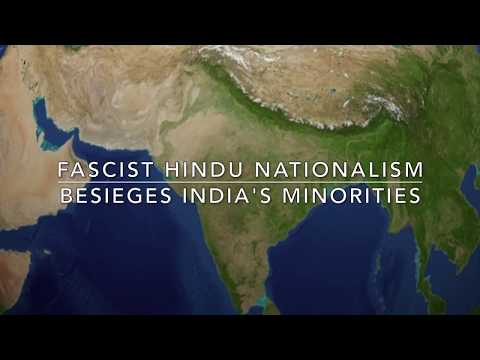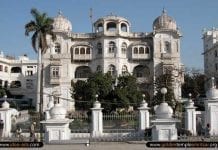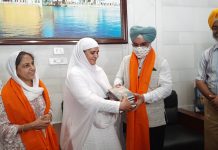Graham Staines, an Australian national, ran a home for lepers in eastern India for 30 years. On the night of January 22, 1999, he was returning from a Christian camp with his two young sons when they stopped to sleep in their car. In the early morning hours, an armed mob of 50 people surrounded their car and set it alight. Staines and his sons Phillip (age 10) and Timothy (age 6) were burned alive.
The ringleader of the mob was Dara, a member of a group called Bajrang Dal, which the CIA’s World Fact Book describes as a “militant religious organization.” [1] That year, Dara continued leading targeted assassinations of minorities. In September 1999, he murdered Catholic priest Arul Das. In November 1999, he murdered Muslim merchant Shaikh Rahman. All the killings occurred in the eastern state of Odisha, but his actions earned praise from far corners. In the western state of Karnataka, one Hindu priest declared, “Dara Singh, who burned Christian missionary Staines at Odisha few years ago, is a role model to us.” [2]
In 2001, the United States Commission on International Religious Freedom (USCIRF) warned about a “disturbing increase in the past several years in severe violence against religious minorities in that country.” [3] As USCIRF reported, “The recent increase in violence against religious minorities has been associated with the rise in power of Hindu nationalist organizations, including the Vishwa Hindu Parishad (VHP), the Bajrang Dal, and the Rashtriya Swayamsevak Sangh (RSS), as well as their political wing, the Bharatiya Janata Party (BJP). These groups are collectively known as the Sangh Parivar.” [4]
From 1998 to 2004, the BJP was India’s ruling party. In 2014, it again rose to power and remains the ruling party today. Currently, the BJP is the ruling party in 15 of 29 Indian states; it is a coalition partner in an additional four states.
Dismal poverty and literacy rates, however, through into question whether or not the ruling party truly represents a democratic choice by the people. According to 2017 data by the Oxford Poverty and Human Development Initiative (OPHI), 41.3% of Indian people live in poverty. Nearly a quarter of the population — 23.1% — live in destitution. OPHI reports, “India has over 295 million destitute people, more than the total number of destitute people in all of Sub-Saharan Africa.” [5] Furthermore, according to 2015 data by the World Bank, India’s literacy rate is only 72%. There is a huge gender disparity, with 81% literacy among men but only 63% among women. [6]
Within this framework, Indian minorities are under siege. Reporting in 2018, USCIRF stated, “In 2017, religious freedom conditions continued a downward trend in India…. Conditions for religious minorities have deteriorated over the last decade due to a multifaceted campaign by Hindu nationalist groups… to alienate non-Hindus or lower-caste Hindus. The victims of this campaign include Muslims, Christians, Sikhs, Buddhists, and Jains, as well as Dalit Hindus, who belong to the lowest rung in the Hindu caste system.” [7]
In February 2018, the festival of love — Valentine’s Day — was greeted with violence by Sangh Parivar groups. “We want to save our daughters and sisters from this type of vulgar presentation of love,” declared Surendra Jain, the international Joint General Secretary of the VHP. [8] Members of VHP, Bajrang Dal, and other outfits rampaged through cities, attacking stores with Valentine’s Day displays, assaulting couples, and generally engaging in unrestrained moral policing. Similarly, over the 2017 Christmas season, Indian Christians fell under attack throughout the country. Priests were arrested for singing Christmas carols, communities received death threats, churches were attacked, cars were burned, and Sangh Parivar groups issued public statements warning Christians not to celebrate the festival.
In 2017, the State of Jharkhand became India’s 9th state to pass an “anti-conversion” law. The law requires converts and the person performing a conversion ceremony to obtain prior permission from their local magistrate; it imposes crippling fines and prison time for conversions deemed false. Furthermore, a wave of lynchings drew international headlines as Muslims and Dalits were stabbed, beaten to death, or burned alive by mobs who accused the victims of possessing beef or harming cows. Journalism website IndiaSpend reported, “2017 has seen a 75% increase in attacks versus the same period in 2016.” Analyzing all related attacks since 2010, the report concluded that 97% occurred after the BJP rose to power in 2014. [9]
A multitude of international bodies are warning about the risks facing Indian minorities.
In 2018, watchdog group Open Doors USA ranked India as the world’s 11th most dangerous country for Christians, stating, “While the source of Christian persecution in India depends on the location within the country, most of it comes from a variety of Hindu radical groups and organizations, including the Bharatiya Janata Party (BJP), Rashtriya Swayamsevak Sangh (RSS), Shiv Sena and Vishwa Hindu Parishad (VHP). Hindu radicals also dominate the central government in New Delhi.” [10]
In 2018, watchdog group Voice of the Martyrs ranked India as “hostile” for Christians, stating, “RSS informants live in nearly every village and report on the activities of Christians, resulting in attacks and arrests…. Churches have been demolished and burned, worship gatherings have been disrupted, crosses in graveyards have been vandalised, Bibles and other Christian literature have been confiscated and burned, and more pastors are being beaten and jailed.” [11]
In 2018, advocacy group Human Rights Watch warned, “Vigilante violence aimed at religious minorities, marginalized communities, and critics of the government — often carried out by groups claiming to support the ruling Bharatiya Janata Party (BJP) — became an increasing threat in India in 2017…. An affiliate organization of the BJP, the Rashtriya Swayamsevak Sangh (RSS), announced plans to recruit 5,000 ‘religious soldiers’ to ‘control cow smuggling and love jihad.’ So-called love jihad, according to Hindu groups, is a conspiracy among Muslim men to marry Hindu women and convert them to Islam.” [12]
The RSS, founded in 1925, is an all-male, uniformed, armed organization with millions of members. It structure and ideology was modeled on the youth movements in fascist Italy and Nazi Germany. The RSS “put forth a vision of India as a land of, and for, Hindus,” explain historians Barbara and Thomas Metcalf. The group are “proponents of a mystical nationalism, with racial overtones that evoked sympathetic parallels with German fascism.” [13] Historian Robert Cowan explains that the RSS “directly imitated European fascist movements of the time,” adding, “Its adherents believe that religious minorities may continue to live in India only if they acknowledge it as a Hindu nation.” [14] According to sociologist Chetan Bhatt, “The RSS can legitimately be seen as one of the largest paramilitary bodies existing in any contemporary nation.” [15]
The RSS and its affiliates have been repeatedly implicated in pogroms of minorities.
In 1992, USCIRF reports, “Hindu nationalists destroyed the 16th century Babri mosque in Ayodhya (in the northern state of Uttar Pradesh), and the ensuing nationwide riots left up to 3,000 dead, mostly Muslims.” [16] The attack began when Member of Parliament L.K. Advani hosted a rally at the mosque. Advani is a member of both the BJP and the RSS. British journalist Mark Tully, an eyewitness, explains, “A vast crowd, perhaps 150,000 strong, had gathered and was listening to speeches given by BJP and right-wing Vishwa Hindu Parishad (VHP) leaders.” [17]
In 2002, USCIRF reports, “Hindu mobs killed 1,200 to 2,500 Muslims across Gujarat, looted or destroyed thousands of mosques and Muslim-owned businesses, and forced more than…. Christians were also victims in Gujarat, and many churches were destroyed.” [18] Amnesty International states, “Some 2000 people, mostly Muslims, were killed and many others were injured and forcibly evicted from their homes and businesses over the course of the following weeks. Violence against women and girls was a key feature of the violence.” [19] Human Rights Watch explains, “The groups most directly responsible for violence against Muslims in Gujarat include the Vishwa Hindu Parishad, the Bajrang Dal, the ruling BJP, and the umbrella organization Rashtriya Swayamsevak Sangh.” [20] Gujarati Chief Minister Narendra Modi, a member of both the BJP and the RSS, was implicated in orchestrating the violence.
In 2008, USCIRF reports, there was “a prolonged and violent campaign targeting Christians in the state of Odisha. Over several weeks, at least 40 individuals were killed, the vast majority of whom were Christians, church properties and thousands of homes were destroyed, and an estimated 60,000 or more Christians fled their homes.” [21] Odishan Chief Minister Naveen Patnaik, who was in office during the pogrom, stated, “Members of RSS, VHP and Bajrang Dal were involved in the violence that took place last year.” [22]
Narendra Modi became Prime Minister of India in 2014. As conditions for religious minorities continue to deteriorate under his regime, the direct influence of the RSS over India’s government has expanded significantly.
In 2015, Indian Home Minister Rajnath Singh — in charge of all internal security for the country — declared, “I want to clarify to everyone that I am an RSS swayamsevak [member] and the Prime Minister is also an RSS swayamsevak [member].” [23] In 2016, The Hindustan Times reported that “more than third of the 66 members in the council of ministers… had an RSS background.” [24] In 2017, BJP President Amit Shah attended a “crucial coordination meeting with various Rashtriya Swayamsevak Sangh (RSS) outfits” before working with Modi to expand the council of ministers. [25]
In May 2018, reported scroll.in, “Bharatiya Janata Party leaders, including party President Amit Shah, and six cabinet ministers met the leadership of the Rashtriya Swayamsevak Sangh… to discuss government programmes and policies.” [26] In June 2018, reported The Asian Age, “Prime Minister Narendra Modi held a crucial meeting with the RSS and BJP brass, which also included BJP president Amit Shah and senior Cabinet ministers, to discuss key electoral issues.” [27]
With the BJP in power, and the RSS and its affiliates extending ideological influence while their foot-soldiers perpetrate acts of violence, the future looks bleak for Indian minorities.
What can citizens in Western countries do to help?
In Canada, the United Kingdom, and the United States, some elected officials have spoken out about the growth of extremist violence in India. Yet in the U.S., the largest and most influential of these Western countries, leading Hindu-Americans and Indian-Americans in federal offices have taken a firm stand in defense of the BJP and its Hindu nationalist agenda. Among these are Representatives Raja Krishnamoorthi (D-IL) and Tulsi Gabbard (D-HI).
In particular, Representative Gabbard is a close friend of India’s leading Hindu nationalists. When Modi became Prime Minister, she stated, “I recently spoke with Narendra Modi by phone and congratulated him and the Bharatiya Janata Party for winning.” [28] When the U.S. banned Modi from entering the country because of his role in the Gujarat violence, she condemned the decision. When fellow Congressional representatives introduced House Resolution 417, which called for U.S. dialogue with India to focus on “religious freedom and related human rights,” she claimed, “It is critically important that we focus on strengthening the ties between the two nations, and I do not believe that H.Res. 417 accomplishes this.” [29]
Additionally, Gabbard has met with Modi on at least four occasions since, including September 2014 in New York, December 2014 in India (a trip which she made at his personal invitation), September 2015 in California, and June 2016 in Washington, D.C.
Gabbard is also working hard to bring the Hindu nationalist agenda to U.S. soil. Among other actions, she has backed Hindu nationalist efforts to propagate revisionist history about India.
When the BJP came to power in 2014, one of its first agenda items was to revise school curriculum to reflect Hindu bias, including portraying mythological events as history. Today, the party continues to advance this agenda. In May 2018, for instance, BJP President Amit Shah deliberate upon various polices of the Narendra Modi government, including the formulation of the much-awaited education policy “met top functionaries of the RSS… to deliberate upon various polices of the Narendra Modi government, including the formulation of the much-awaited education policy.” [30] Gabbard supports importing this joint BJP/RSS effort to U.S. educational institutions. In 2017, when Hindu nationalists internationalized this agenda by demanding revision of California textbooks, Gabbard wrote to the California State Board of Education to urge them to accept a long list of controversial changes. According to an article in Salon, changes primarily focused on “minimization of the impacts of the caste system.” The goal of the textbook revisions “is the construction of India as a historically Hindu nation, disenfranchising Dalits, making Sikhs and Buddhists invisible, and identifying Christians and Muslims as ‘foreigners.’” [31]
While India lies on the opposite side of the world from the U.S., elected officials have an opportunity to defend the lives of Indian minorities by dialoguing with India about religious freedom and human rights issues. Instead of speaking against the actions of the Sangh Parivar in India, however, officials like Gabbard and Krishnamoorthi are working hard to pave the way for such groups to work on U.S. soil.
In September 2018, the Vishwa Hindu Parishad of America (VHPA — the U.S. branch of the VHP, which the CIA labels a “militant religious organization”) will host the World Hindu Congress 2018 in Chicago. Both Krishnamoorthi and Gabbard issued public statements eagerly accepting invitations to the conference. Gabbard accepted an invitation to chair the conference [later backing out]. Prominent guests, however, include BJP politicians Narendra Modi and Yogi Adityanath (the controversial Chief Minister of India’s largest state, Uttar Pradesh), as well as Mohan Bhagwat, the Supreme Leader of the RSS.
The lives of India’s minorities are vulnerable as they remain under siege by militant Sangh Parivar groups who have declared their intention to exterminate non-Hindus from India. These groups are planting deep roots in the U.S., where they are setting up sleeper cell organizations with influence over primary school curriculum, universities, and elected officials. Their reach extends to the highest offices in the land.
American citizens can help besieged Indian minorities by learning about the threats facing them and then calling on U.S. elected officials — especially Gabbard and Krishnamoorthi — to denounce the actions of the BJP, the RSS, and affiliated groups and to disassociate from such extremists.
CITATIONS:
1. “CIA names VHP, Bajrang Dal as ‘religious militant organisations’ in World Factbook.” The Indian Express. June 15, 2018.
2. Cork, Matthew and Kenneth Kemp. Why Not Today: Trafficking, Slavery, the Global Church… And You. Chicago: Moody Publishers. 2013. Chapter 6.
3. United States Commission on International Religious Freedom (USCIRF). “Annual Report of the United States Commission on International Religious Freedom.” August 2009. India Chapter. 1.
4. Ibid. May 2001. India Chapter. 55.
5. Alkire, Sabina and Gisela Robles. “Global Multidimensional Poverty Index 2017.” OPHI BRIEFING 48. Oxford Poverty & Human Development Index Initiative. June 2017.
6. World Bank. “World Development Indicators.” November 2017. Accessed at statista.com.
7. USCIRF. “Annual Report.” April 2018. India Chapter. 2.
8. Flock, Elizabeth. “The War on Valentine’s Day in India.” The Atlantic. February 14, 2018.
9. Abraham, Delna and Ojaswi Rao. “84% Dead In Cow-Related Violence Since 2010 Are Muslim; 97% Attacks After 2014.” IndiaSpend.com. June 28, 2017.
10. OpenDoors. “2018 World Watch List Report.” January 2018. India Profile.
11. Voice of the Martyrs. “2018 Global Prayer Guide.” 22.
12. Human Rights Watch. “World Report 2018.” January 2018. 261 & 263.
13. Metcalf, Barbara and Thomas Metcalf. A Concise History of Modern India. 2001. Cambridge: Cambridge University Press. 2006. 229.
14. Cowan, Robert. The Indo-German Identification: Reconciling South Asian Origins and European Destinies, 1765-1885. Rochester: Camden House. 2010. 182.
15. Kaufman, Eric. P (ed). Rethinking Ethnicity: Majority Groups and Dominant Minorities. London: Routledge. 2004. 213.
16. USCIRF. “Annual Report.” May 2001. India Chapter. 50.
17. Tully, Mark. “Tearing Down the Babri Masjid.” BBC News. December 5, 2002.
18. USCIRF. “Annual Report.” May 2011. India Chapter. 247.
19. Amnesty International. “India: Justice, the victim – Gujarat state fails to protect women from violence.” AI Index: ASA 20/001/2005. January 27, 2005.
20. Human Rights Watch. “‘We Have No Orders to Save You’: State Participation and Complicity in Communal Violence in Gujarat.” April 2002. 4.
21. USCIRF. “Annual Report.” May 2009. India Chapter. 2.
22. “Sangh parivar activists involved in Kandhamal riot.” Zee News. November 24, 2009.
23. “We’re Swayamsevaks, but RSS not running government: Rajnath.” The Hindustan Times. March 7, 2017.
24. “PM Modi’s new cabinet has strong RSS imprint.” The Hindustan Times. July 7, 2016.
25. “Sunday reshuffle: 9 new ministers to take oath.” rediff.com. September 2, 2017.
26. “Amit Shah and six Cabinet ministers meet RSS leadership to discuss government policies.” scroll.in. May 28, 2018.
27. Gusai, Yojna. “PM, ministers review key issues with RSS leaders.” The Asian Age. June 18, 2018.
28. Office of Congresswoman Tulsi Gabbard. “Rep. Tulsi Gabbard Congratulates Indian Leader Narendra Modi on Party Victory.” gabbard.house.gov. May 16, 2014.
29. Hindu American Foundation. “First Hindu Member of Congress Opposes Anti-India Resolution, H. Res. 417.” hafsite.org. December 19, 2013.
30. “Amit Shah, ministers meet RSS functionaries.” The Times of India. May 28, 2018.
31. Pandit, Eesha. “There’s a new battle raging in California over history textbooks. Here’s what you need to know.” salon.com. May 16, 2016.






[…] https://www.sikh24.com/2018/09/08/fascist-hindu-nationalism-besieges-indias-minorities/#.W5aBMfZ9jIU […]